Page 2616 of 3383
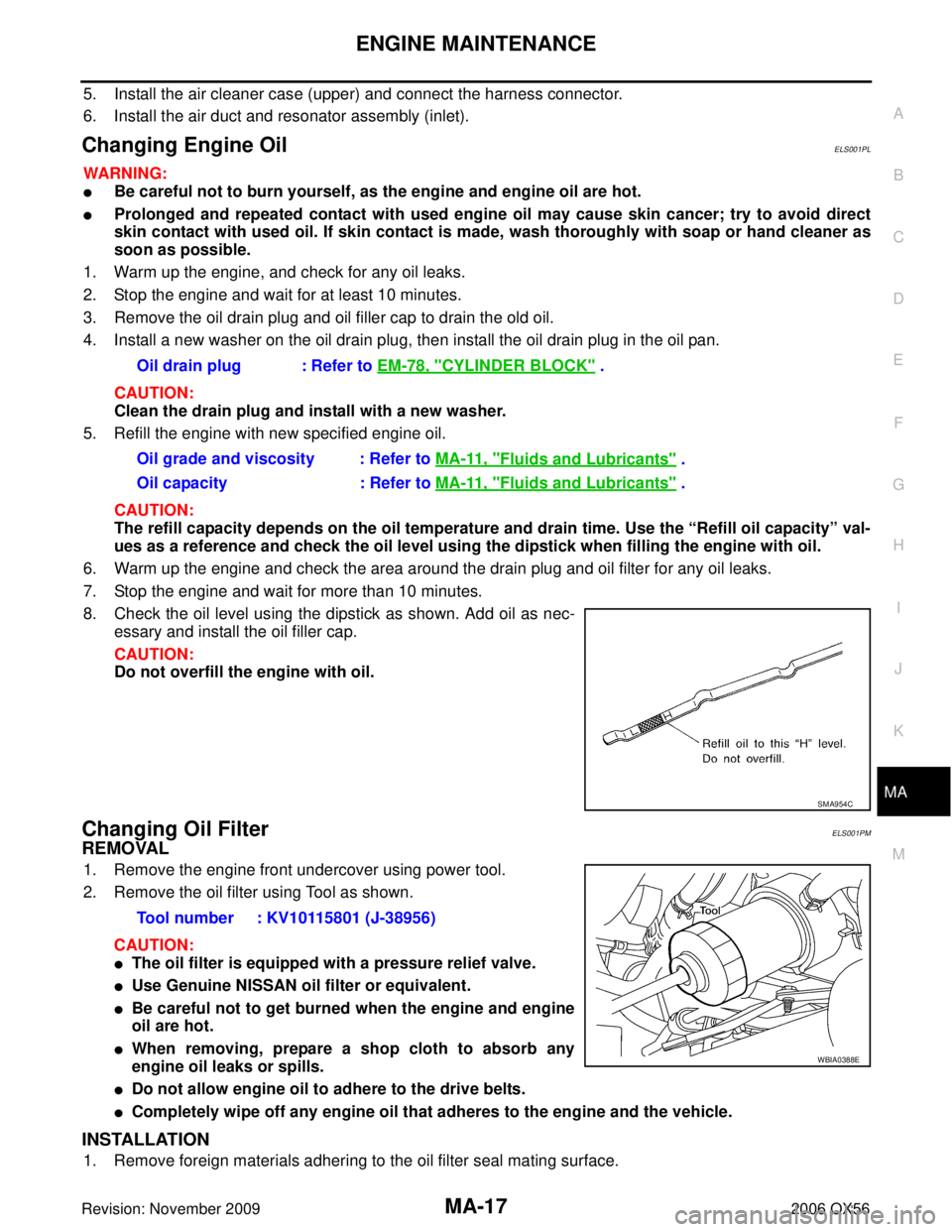
ENGINE MAINTENANCEMA-17
C
DE
F
G H
I
J
K
M A
B
MA
Revision: November 2009 2006 QX56
5. Install the air cleaner case (upper) and connect the harness connector.
6. Install the air duct and resonator assembly (inlet).
Changing Engine OilELS001PL
WARNING:
�Be careful not to burn yourself, as the engine and engine oil are hot.
�Prolonged and repeated contact with used engine oil may cause skin cancer; try to avoid direct
skin contact with used oil. If skin contact is made, wash thoroughly with soap or hand cleaner as
soon as possible.
1. Warm up the engine, and check for any oil leaks.
2. Stop the engine and wait for at least 10 minutes.
3. Remove the oil drain plug and oil filler cap to drain the old oil.
4. Install a new washer on the oil drain plug, then install the oil drain plug in the oil pan.
CAUTION:
Clean the drain plug and install with a new washer.
5. Refill the engine with new specified engine oil.
CAUTION:
The refill capacity depends on the oil temperature and drain time. Use the “Refill oil capacity” val-
ues as a reference and check the oil level using the dipstick when filling the engine with oil.
6. Warm up the engine and check the area around the drain plug and oil filter for any oil leaks.
7. Stop the engine and wait for more than 10 minutes.
8. Check the oil level using the dipstick as shown. Add oil as nec- essary and install the oil filler cap.
CAUTION:
Do not overfill the engine with oil.
Changing Oil FilterELS001PM
REMOVAL
1. Remove the engine front undercover using power tool.
2. Remove the oil filter using Tool as shown.
CAUTION:
�The oil filter is equipped with a pressure relief valve.
�Use Genuine NISSAN oil filter or equivalent.
�Be careful not to get burned when the engine and engine
oil are hot.
�When removing, prepare a shop cloth to absorb any
engine oil leaks or spills.
�Do not allow engine oil to adhere to the drive belts.
�Completely wipe off any engine oil that adheres to the engine and the vehicle.
INSTALLATION
1. Remove foreign materials adhering to the oil filter seal mating surface. Oil drain plug : Refer to EM-78, "
CYLINDER BLOCK" .
Oil grade and viscosity : Refer to MA-11, "
Fluids and Lubricants" .
Oil capacity : Refer to MA-11, "
Fluids and Lubricants" .
SMA954C
Tool number : KV10115801 (J-38956)
WBIA0388E
Page 2617 of 3383
MA-18
ENGINE MAINTENANCE
Revision: November 20092006 QX56
2. Apply clean engine oil to the oil filter seal circumference of the
new oil filter.
3. Screw the oil filter manually until it touches the installation sur- face, then tighten it by 2/3 turn. Or tighten to specification.
4. Inspect the engine for oil leaks. Refer to MA-18, "
INSPECTION
AFTER INSTALLATION" .
5. Install the engine front undercover using power tool.
INSPECTION AFTER INSTALLATION
1. Check the oil level using the dipstick as shown. Add oil as nec- essary.
CAUTION:
Do not overfill the engine with oil.
2. Start the engine and check for engine oil leaks.
3. Stop the engine and wait for 10 minutes.
4. Check the engine oil level and add engine oil as required.
Changing Spark PlugsELS001PN
SMA010
Oil filter : 17.7 N·m (1.8 kg-m, 13 ft-lb)
SMA229B
SMA954C
1. Ignition coil 2. Spark plug
WBIA0796E
Page 2618 of 3383
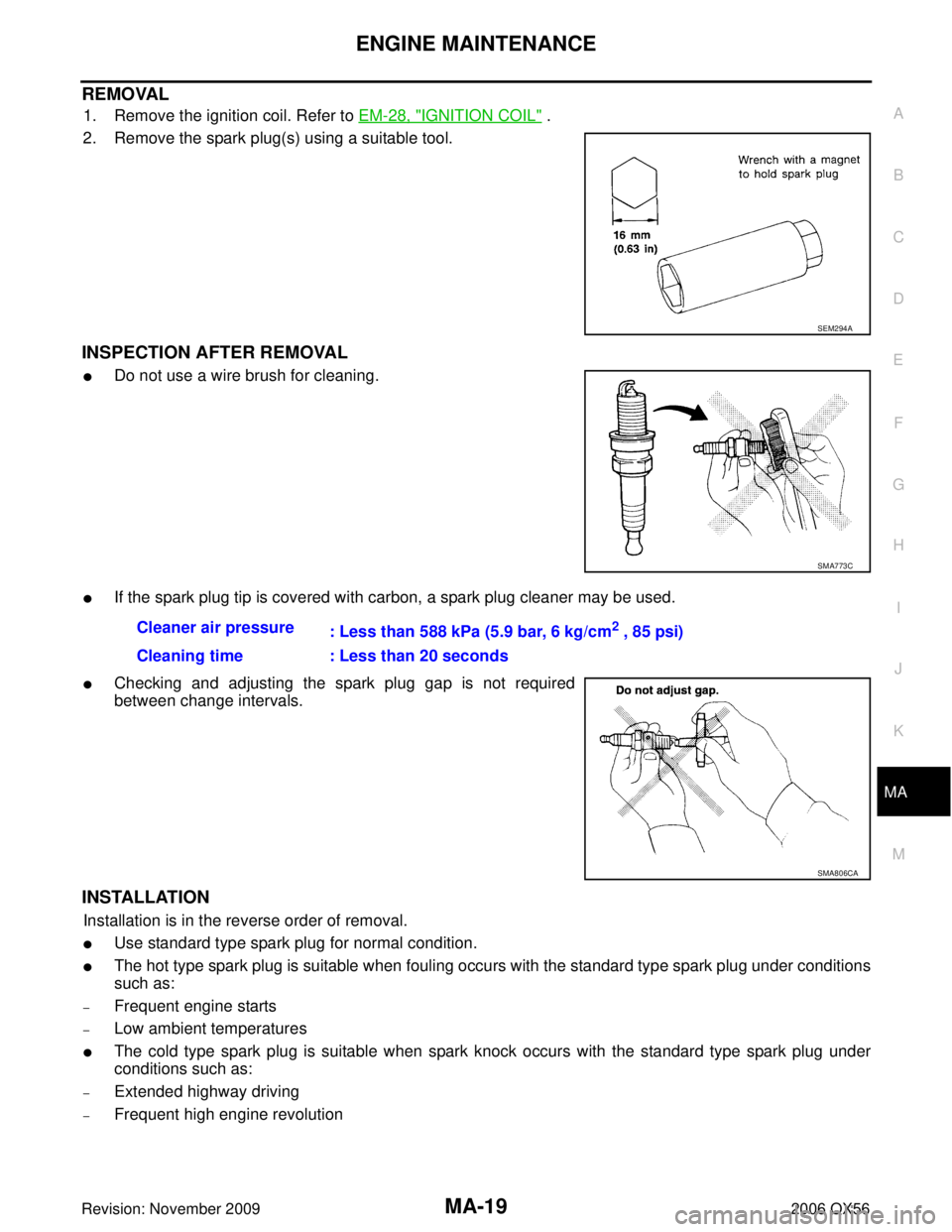
ENGINE MAINTENANCEMA-19
C
DE
F
G H
I
J
K
M A
B
MA
Revision: November 2009 2006 QX56
REMOVAL
1. Remove the ignition coil. Refer to EM-28, "IGNITION COIL" .
2. Remove the spark plug(s) using a suitable tool.
INSPECTION AFTER REMOVAL
�Do not use a wire brush for cleaning.
�If the spark plug tip is covered with carbon, a spark plug cleaner may be used.
�Checking and adjusting the spark plug gap is not required
between change intervals.
INSTALLATION
Installation is in the reverse order of removal.
�Use standard type spark plug for normal condition.
�The hot type spark plug is suitable when fouling occurs with the standard type spark plug under conditions
such as:
–Frequent engine starts
–Low ambient temperatures
�The cold type spark plug is suitable when spark knock occurs with the standard type spark plug under
conditions such as:
–Extended highway driving
–Frequent high engine revolution
SEM294A
SMA773C
Cleaner air pressure : Less than 588 kPa (5.9 bar, 6 kg/cm2 , 85 psi)
Cleaning time : Less than 20 seconds
SMA806CA
Page 2619 of 3383
MA-20
ENGINE MAINTENANCE
Revision: November 20092006 QX56
CAUTION:
Do not drop or shock spark plug.
Checking EVAP Vapor LinesELS001PO
1. Visually inspect the EVAP vapor lines for improper attachment, cracks, damage, loose connections, chaf-
ing, or deterioration.
2. Inspect the vacuum relief valve of the fuel tank filler cap for clogging and sticking. Refer to EC-37, "
How to Detect Fuel Vapor Leakage" .
Make NGK
Model StandardFFV
Standard type DILFR5A-11DILFR5A-11D
Gap (Nominal) :1.1 mm (0.043 in)
Page 2620 of 3383
CHASSIS AND BODY MAINTENANCEMA-21
C
DE
F
G H
I
J
K
M A
B
MA
Revision: November 2009 2006 QX56
CHASSIS AND BODY MAINTENANCEPFP:00100
Changing In-cabin MicrofilterELS001PP
1. Remove the two lower glove box hinge pins to remove the glove
box from the instrument panel and let it hang from the cord.
2. Remove the screw and remove the in-cabin microfilter cover.
3. Remove the in-cabin microfilters from the front heater and cool- ing unit assembly housing.
4. Insert the first new in-cabin microfilter into the front heater and cooling unit assembly housing and slide it over to the right.
Insert the second new in-cabin microfilter into the front heater
and cooling unit assembly housing.
NOTE:
The in-cabin microfilters are marked with air flow arrows. The
end of the microfilter with the arrow should face the rear of the
vehicle. The arrows should point downward.
5. Install the in-cabin microfilter cover.
WLIA0027E
LJIA0134E
LJIA0148E
LJIA0134E
Page 2621 of 3383
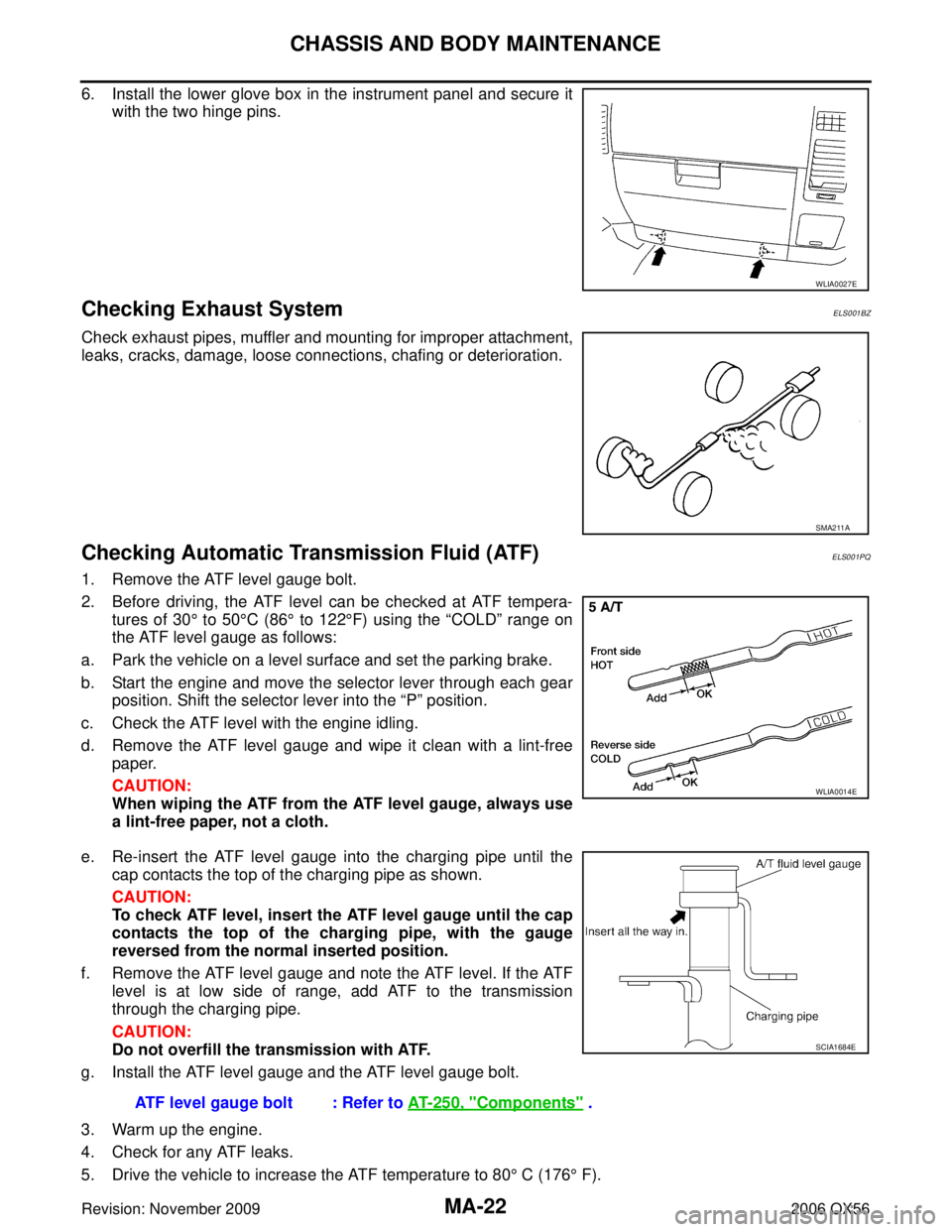
MA-22
CHASSIS AND BODY MAINTENANCE
Revision: November 20092006 QX56
6. Install the lower glove box in the instrument panel and secure it
with the two hinge pins.
Checking Exhaust SystemELS001BZ
Check exhaust pipes, muffler and mounting for improper attachment,
leaks, cracks, damage, loose connections, chafing or deterioration.
Checking Automatic Transmission Fluid (ATF)ELS001PQ
1. Remove the ATF level gauge bolt.
2. Before driving, the ATF level can be checked at ATF tempera-tures of 30 ° to 50 °C (86 ° to 122 °F) using the “COLD” range on
the ATF level gauge as follows:
a. Park the vehicle on a level surface and set the parking brake.
b. Start the engine and move the selector lever through each gear position. Shift the selector lever into the “P” position.
c. Check the ATF level with the engine idling.
d. Remove the ATF level gauge and wipe it clean with a lint-free paper.
CAUTION:
When wiping the ATF from the ATF level gauge, always use
a lint-free paper, not a cloth.
e. Re-insert the ATF level gauge into the charging pipe until the cap contacts the top of the charging pipe as shown.
CAUTION:
To check ATF level, insert the ATF level gauge until the cap
contacts the top of the charging pipe, with the gauge
reversed from the normal inserted position.
f. Remove the ATF level gauge and note the ATF level. If the ATF level is at low side of range, add ATF to the transmission
through the charging pipe.
CAUTION:
Do not overfill the transmission with ATF.
g. Install the ATF level gauge and the ATF level gauge bolt.
3. Warm up the engine.
4. Check for any ATF leaks.
5. Drive the vehicle to increase the ATF temperature to 80 ° C (176 ° F).
WLIA0027E
SMA211A
WLIA0014E
ATF level gauge bolt : Refer to AT- 2 5 0 , "Components" .
SCIA1684E
Page 2622 of 3383
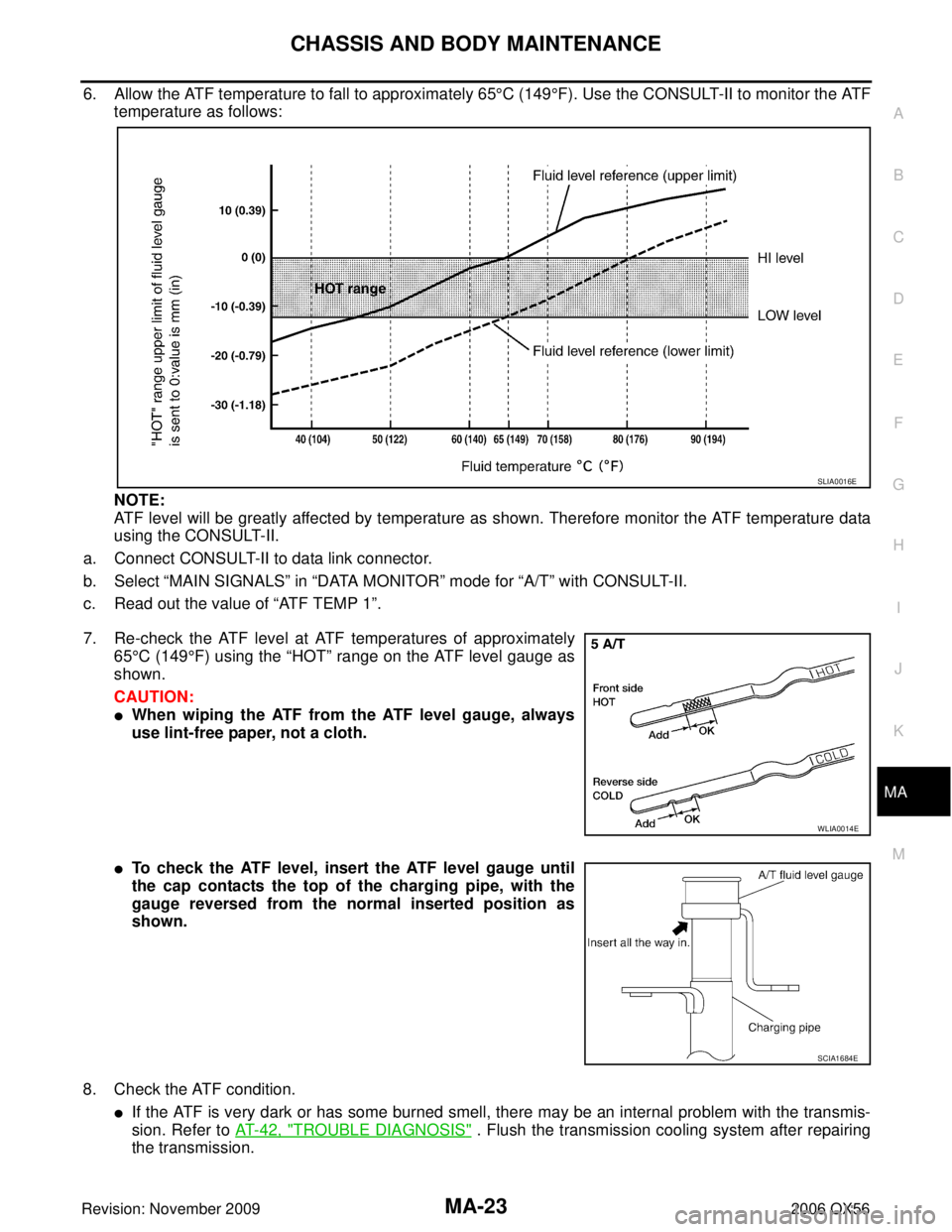
CHASSIS AND BODY MAINTENANCEMA-23
C
DE
F
G H
I
J
K
M A
B
MA
Revision: November 2009 2006 QX56
6. Allow the ATF temperature to fall to approximately 65°C (149 °F). Use the CONSULT-II to monitor the ATF
temperature as follows:
NOTE:
ATF level will be greatly affected by temperature as shown. Therefore monitor the ATF temperature data
using the CONSULT-II.
a. Connect CONSULT-II to data link connector.
b. Select “MAIN SIGNALS ” in “DATA MONITOR ” mode for “A/T” with CONSULT-II.
c. Read out the value of “ATF TEMP 1”.
7. Re-check the ATF level at ATF temperatures of approximately 65°C (149 °F) using the “HOT ” range on the ATF level gauge as
shown.
CAUTION:
�When wiping the ATF from the ATF level gauge, always
use lint-free paper, not a cloth.
�To check the ATF level, insert the ATF level gauge until
the cap contacts the top of the charging pipe, with the
gauge reversed from the normal inserted position as
shown.
8. Check the ATF condition.
�If the ATF is very dark or has some burned smell, there may be an internal problem with the transmis-
sion. Refer to AT- 4 2 , "
TROUBLE DIAGNOSIS" . Flush the transmission cooling system after repairing
the transmission.
SLIA0016E
WLIA0014E
SCIA1684E
Page 2623 of 3383
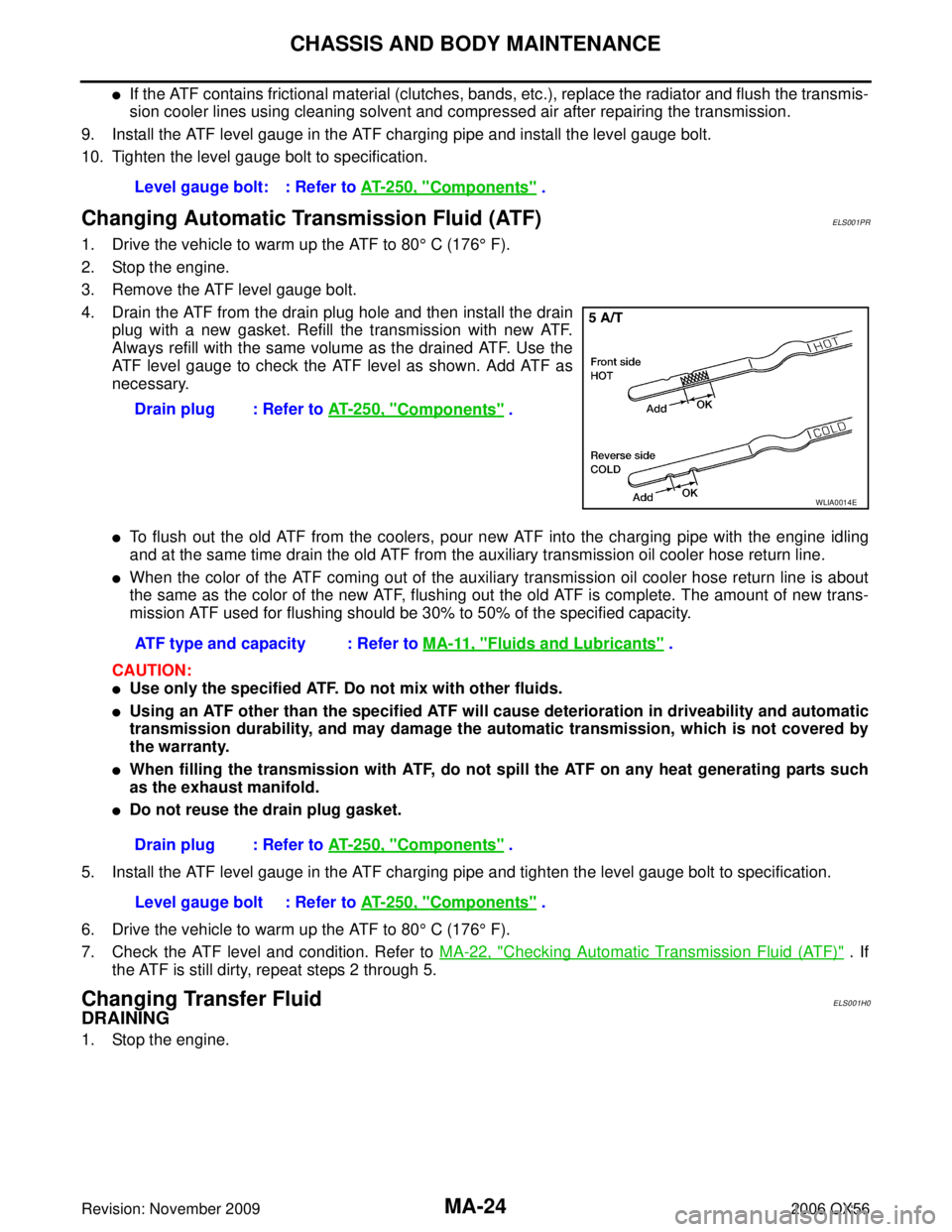
MA-24
CHASSIS AND BODY MAINTENANCE
Revision: November 20092006 QX56
�If the ATF contains frictional material (clutches, bands, etc.), replace the radiator and flush the transmis-
sion cooler lines using cleaning solvent and compressed air after repairing the transmission.
9. Install the ATF level gauge in the ATF charging pipe and install the level gauge bolt.
10. Tighten the level gauge bolt to specification.
Changing Automatic Transmission Fluid (ATF)ELS001PR
1. Drive the vehicle to warm up the ATF to 80 ° C (176 ° F).
2. Stop the engine.
3. Remove the ATF level gauge bolt.
4. Drain the ATF from the drain plug hole and then install the drain plug with a new gasket. Refill the transmission with new ATF.
Always refill with the same volume as the drained ATF. Use the
ATF level gauge to check the ATF level as shown. Add ATF as
necessary.
�To flush out the old ATF from the coolers, pour new ATF into the charging pipe with the engine idling
and at the same time drain the old ATF from the auxiliary transmission oil cooler hose return line.
�When the color of the ATF coming out of the auxiliary transmission oil cooler hose return line is about
the same as the color of the new ATF, flushing out the old ATF is complete. The amount of new trans-
mission ATF used for flushing should be 30% to 50% of the specified capacity.
CAUTION:
�Use only the specified ATF. Do not mix with other fluids.
�Using an ATF other than the specified ATF will cause deterioration in driveability and automatic
transmission durability, and may damage the automatic transmission, which is not covered by
the warranty.
�When filling the transmission with ATF, do not spill the ATF on any heat generating parts such
as the exhaust manifold.
�Do not reuse the drain plug gasket.
5. Install the ATF level gauge in the ATF charging pipe and tighten the level gauge bolt to specification.
6. Drive the vehicle to warm up the ATF to 80 ° C (176 ° F).
7. Check the ATF level and condition. Refer to MA-22, "
Checking Automatic Transmission Fluid (ATF)" . If
the ATF is still dirty, repeat steps 2 through 5.
Changing Transfer FluidELS001H0
DRAINING
1. Stop the engine. Level gauge bolt: : Refer to
AT- 2 5 0 , "
Components" .
Drain plug : Refer to AT- 2 5 0 , "
Components" .
WLIA0014E
ATF type and capacity : Refer to MA-11, "Fluids and Lubricants" .
Drain plug : Refer to AT- 2 5 0 , "
Components" .
Level gauge bolt : Refer to AT- 2 5 0 , "
Components" .